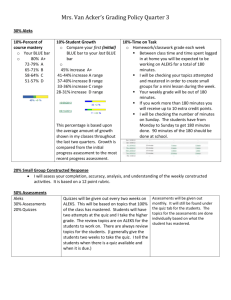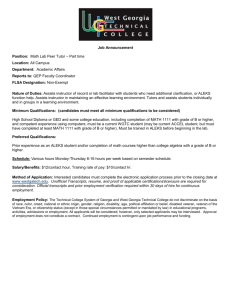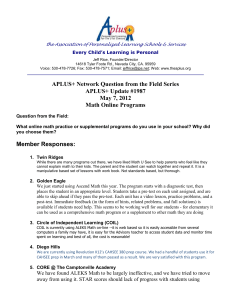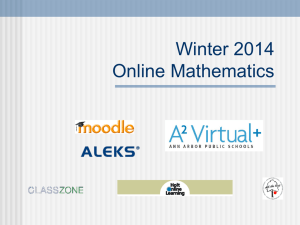Accessibility of ALEKS Course Products
advertisement
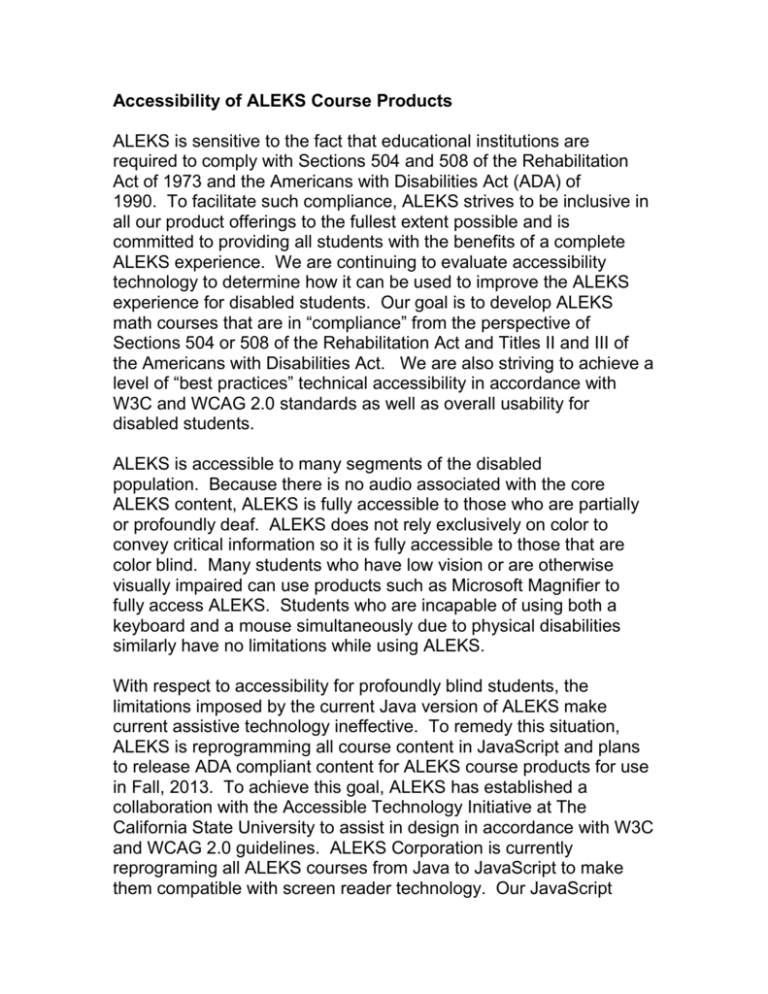
Accessibility of ALEKS Course Products ALEKS is sensitive to the fact that educational institutions are required to comply with Sections 504 and 508 of the Rehabilitation Act of 1973 and the Americans with Disabilities Act (ADA) of 1990. To facilitate such compliance, ALEKS strives to be inclusive in all our product offerings to the fullest extent possible and is committed to providing all students with the benefits of a complete ALEKS experience. We are continuing to evaluate accessibility technology to determine how it can be used to improve the ALEKS experience for disabled students. Our goal is to develop ALEKS math courses that are in “compliance” from the perspective of Sections 504 or 508 of the Rehabilitation Act and Titles II and III of the Americans with Disabilities Act. We are also striving to achieve a level of “best practices” technical accessibility in accordance with W3C and WCAG 2.0 standards as well as overall usability for disabled students. ALEKS is accessible to many segments of the disabled population. Because there is no audio associated with the core ALEKS content, ALEKS is fully accessible to those who are partially or profoundly deaf. ALEKS does not rely exclusively on color to convey critical information so it is fully accessible to those that are color blind. Many students who have low vision or are otherwise visually impaired can use products such as Microsoft Magnifier to fully access ALEKS. Students who are incapable of using both a keyboard and a mouse simultaneously due to physical disabilities similarly have no limitations while using ALEKS. With respect to accessibility for profoundly blind students, the limitations imposed by the current Java version of ALEKS make current assistive technology ineffective. To remedy this situation, ALEKS is reprogramming all course content in JavaScript and plans to release ADA compliant content for ALEKS course products for use in Fall, 2013. To achieve this goal, ALEKS has established a collaboration with the Accessible Technology Initiative at The California State University to assist in design in accordance with W3C and WCAG 2.0 guidelines. ALEKS Corporation is currently reprograming all ALEKS courses from Java to JavaScript to make them compatible with screen reader technology. Our JavaScript programming strategy incorporates WAI-ARIA to allow dynamic content and advanced user interface controls developed in JavaScript to interact more readily with screen readers. The early releases of the accessible Basic Math, Beginning Algebra and Intermediate Algebra courses are now the subject of testing and review. Within these courses, most content will be fully accessible. However, we have evaluated current screen reader technology and have determined it to be unsatisfactory in Math with regard to problems which are visually demanding (as is the case in a number of topics in Beginning and Intermediate Algebra). As we move toward greater accessibility in more advanced courses, we recognize the need to research, develop and implement accessible input tools in regard to open-ended Math problems for which answers can be entered in free response form while reducing the extent to which such input tools are visually demanding. Mathematics as early as Pre-Algebra is highly visual. Math textbooks and software naturally contain vast amounts of mathematical notation, graphs, and other forms of diagrams and pictures that are visual in nature. For many mathematical topics, the understanding derived through visualizing the mathematical concepts involved cannot be replicated easily, if at all, by available screen reader technology. This problem is inherent in Math and is faced by all providers of online Math content. Those that claim that all of their online Math content is fully compliant with the ADA, Section 504 or Section 508 are likely exaggerating their capabilities in this regard. The validity of such claims, therefore, should be thoroughly tested. To assist a profoundly blind student, it is most effective to convert these images into a raised form – a tactile diagram – that can be interpreted by touch. Using Alt Tags to describe complex graphs is a poor substitute for visualization or tactile diagrams. Even a highly detailed verbal description of a complex graph without tactile supplementation is unlikely to achieve the intended learning goal. Modification of math courses to eliminate complex graphing elements would adversely impact the intended learning outcomes of the course. As a result, ALEKS believes that such a modification would fundamentally alter the core functionality of these courses. Given the current state of assistive technology, many schools that have addressed the issue of teaching mathematics to profoundly blind students have determined that an “alternative accessible arrangement” in the form of human assistance (qualified readers or transcribers to record answers) is the best accommodation for those students as they work through either a traditional math curriculum and textbook or as they work with ALEKS. This approach is also consistent with their approach to other visually demanding course work. We recognize that educational institutions must provide accommodations or modifications that would permit disabled students to receive all the educational benefits provided by the ALEKS technology in an equally effective and equally integrated manner. One of our goals in working with the California State University is to develop ALEKS course products that retain the core nature and functionality of ALEKS artificial intelligence and learning outcomes while being accessible to blind or extremely visually impaired students. We are committed to broadening the accessibility of ALEKS and continuing to evaluate accessibility technology to determine how it can be used to improve the ALEKS experience for disabled students.

